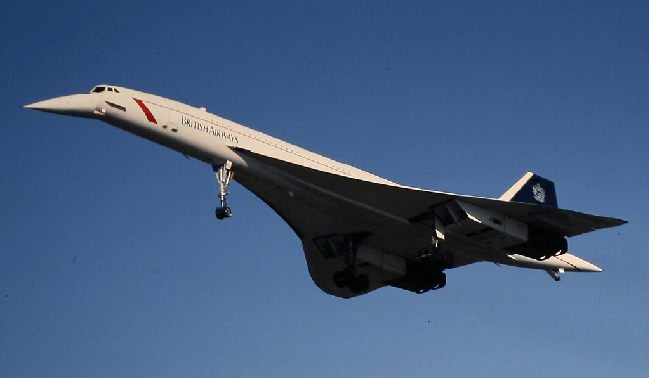Imagine being served countless glasses of champagne, Angus beef, Scottish smoked salmon, caviar, lobster, guinea fowl, truffles, and foie gras on an airliner cruising at 30,000 feet while traveling at twice the speed of sound.
Imagine just 100 seats in a gigantic plane with a 2×2 seat configuration. You overtake Boeings cruising below you, warning them of that explosive sound when you are zooming ahead at twice their speed. Yet, this was a reality in the 1970s and the 80s when the Concorde ferried rich and famous from New York to London in under four hours!
It was a plane made for the rich and famous. A design that resembled a pterodactyl, with just 100 plush seats and six-star service on board. Flying by the Concorde was a status symbol. No wonder the celebs loved it.

The Concorde was a technological marvel. With a top speed of 2,179 kilometers per hour or Mach 2.04, the aircraft was one of world’s first commercial supersonic transport (SST) and stayed in service for close to three decades.
In the 70s, the aircraft had very advanced technology onboard. The electrically-controlled analog fly-by-wire flight control systems coupled with full autopilot and autothrottle system made the aircraft relatively easy to fly as it allowed ‘hands-off’ control of the aircraft from take-off to landing. The aircraft was also provided with an air data computer. Mind you, this was the 70s!
Jointly designed by France’s Aérospatiale and British Aircraft Corporation (BAC) of the United Kingdom, the supersonic transport (SST) first took to the skies on March 2nd, 1969. It was powered by four Rolls Royce/Snecma Olympus 593 engines and was inducted into regular commercial service in 1976.
The plane flew until 2001, when it was briefly grounded due to a fatal crash. The Concorde was officially retired from commercial service in 2003. It went out of service, not for lack of clientele, but because of its breaking the sound barrier every time it flew. People who lived near Heathrow complained of shattered windows.
The Soviet Competitor
Conscious of the glamour and exclusivity surrounding the Concorde and the attention it was generating, the Soviets were secretly working hard on their own supersonic transport aircraft – The Tupolev Tu-144.
The USSR achieved a breakthrough when the Tu-144 took off for its maiden flight in December 1968 and went supersonic on June 5th, 1969, four months before the Concorde!
In 1970, it became the first commercial transport aircraft to fly at Mach 2.0. The BBC quoting Jack Lowe, a British Airways flight operations manager, said in a report: “The rivalry between Concorde and the Tu-144 was symptomatic of that international era.”
It was an era of intense technological competition between the West and the now-defunct Soviet Union. But such was the Russian technological prowess that French President Georges Pompidou, when he saw it at the Paris Air Show, exclaimed, “A beautiful plane.” The makers of Concorde, setting aside rivalry, conceded that it was “quieter and cleaner.”
“Quieter”. That was an important concession from a rival. Ultimately, that is what sank the Concorde, its explosive sound barrier-breaking speed, which set the teeth on edge for residents near Heathrow and grounded it forever.
With the Soviets and Western nations competing with each other to conquer space, the rivalry between Tu-144 and Concorde was intense and a matter of prestige for both sides.
Despite its initial success, the Tu-144 would never make it as far as the Concorde. It was plagued by development and reliability issues. The crash of a Tu-144 at the Paris Air Show was a massive setback to the program.
It was introduced into commercial passenger service in 1975 only to be withdrawn three years later due to its poor safety record and reliability issues. The aircraft was later used to transport cargo and conducted a couple of test flights for NASA for placing satellites in space.
The American Dream
It all began in the early sixties. Backed by then-President John F. Kennedy, the United States, too, was exploring feasible SST options. Lockheed Martin, North American Aviation (NAA), and Boeing were at the forefront of these efforts.
Boeing came up with the design for a variable geometry “swing-wing” aircraft called Boeing 2707, which won the American SST competition, sidelining the concepts by Lockheed Martin and North American Aviation (NAA).
But it was a dream that was never realized. Marred by government budget cuts, environmental concerns, and the lack of a niche market ensured that the Boeing 2707 just remained a concept on paper. The fact the SSTs were gas guzzlers and cost a small fortune to maintain did not help either.
A not-so-rosy past and a beckoning future
But the legend of the Concorde, TU-144 and the failed attempts by the Americans have not ended the dream of the airlines to have a superfast aircraft.
Despite many companies toying with the idea of a supersonic aircraft in the past and having dumped it too, aviation firms have not given up on the idea. The Japanese Space Agency JAXA is working on its Next Generation Supersonic Transport Jet.
US companies – Boom Supersonic is working on its prototype XB-1. Aerion Supersonic has its AS2 aircraft in the works, while Spike Aerospace is aiming to produce the fastest civilian aircraft. Boeing, too, is working on a hypersonic aircraft design.
Looking at the history of supersonic air transport, it can be concluded the Anglo-French Concorde made it, the Soviet Tu-144 came very close, while the American Boeing only remained a pipe dream.
Will the new SST designs succeed, and can supersonic commercial travel make a comeback again? At a time when time is money, the rich and influential will finally decide.